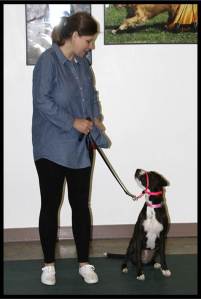Operant learning is all about consequences. Most trainers and behaviorists are well-versed in the uses of pleasant and aversive stimuli as dog training consequences. These can be constructed into a 2 x 2 matrix that includes the type of stimulus (desirable/pleasant or aversive/unpleasant) as one factor and the intended behavioral change (increase or decrease response frequency) as the second factor (1).
Learning occurs when one of these four consequences lead to a change in the dog’s behavior:
-
Positive reinforcement (+R): Delivery (acquisition) of a desirable stimulus (food treat, praise, petting, play) results in an increase in the response. Example: Dog increases “sit” response to acquire petting and a food treat.
- Negative Reinforcement (-R): Disappearance (avoidance) of an aversive stimulus (head collar pressure, collar jerk, harsh voice) results in an increase in the response that allows the dog to avoid the unpleasant stimulus. Example: Dog increases “sit” response to avoid pressure applied to head collar or collar jerk (or to avoid a horrible “ehhhh” sound emanating from the trainer. How do people produce that sound, anyway?)
- Positive Punishment (+P): Delivery of an aversive stimulus results in a decrease in response. Example: Dog decreases standing/lying down/moving away from a sit position to avoid pressure applied to head collar or collar jerk (or the horrible “ehhhh” sound).
- Negative Punishment (-P): Removal of a desirable stimulus results in a decrease in the response. Example: Dog decreases standing/lying down to avoid losing access to food treats, petting praise attained whilst sitting quietly.

 Petting (Desirable) The dreaded “Ehhhh” sound (Aversive)
Petting (Desirable) The dreaded “Ehhhh” sound (Aversive)
The Hypothesis: There is a general (but certainly not universal) consensus among trainers and behaviorists that training methods that emphasize positive reinforcement are more effective and more humane than those that emphasize the use of aversive stimuli. To date, there is some evidence in the scientific literature that supports +R methods as more effective than -R (see Yogi Bear Dogs ). And now, there is a study that examines the effects of these two different training approaches upon dogs’ levels of stress and their relationships with their owners (2).
The Study: Stephanie Deldalle and Florence Gaunet of the University of Paris-Nord and the Laboratoire de Psychologie Cognitive conducted an exploratory study that observed two dog training schools and their students during a series of advanced training classes. One school used primarily +R methods in the form of food treats, praise and petting to increase desired behaviors in the dogs. The second school used primarily -R methods in the form of collar corrections (pressure/jerks) and physical manipulation (pushing the dog into a sit). Neither the schools’ instructors nor their students were aware of the study’s objectives or that their school had been selected because of the type of methods that were used.
Methods: A group of 24 owner-dog pairs training at the +R school (hereafter +RS) and a group of 26 owner-dog pairs at the -R school (hereafter -RS) were studied. The dogs represented a variety of breeds and ranged in age from 8 months to 7 years. One researcher attended two sessions of a one-hour advanced class at each school and collected data for 50 minutes during each visit. Data collected included the owner’s behavior and the dog’s response and body postures when walking on a loose lead and when responding to the “sit” command. Within each session the frequencies of +R and -R stimuli used by the observed owners were also recorded. Owners were asked to complete a questionnaire at the end of the session.
Results: No differences in owner demographics or dog characteristics were found between the +RS and the -RS groups. Training results were classified by activity:
- Response to sit command: Dogs trained using primarily -R showed significantly more mouth licking (38 % vs. 8 % of dogs), yawning (12 % vs. 0 % of dogs), and lowered body posture (46 % vs. 8 %) when compared with dogs trained with +R, behaviors that are all associated with stress. Altogether, 65 percent of dogs in the -RS group demonstrated at least one stress-related behavior, compared with only 8 percent of dogs in the +RS group. Conversely, significantly more dogs in the +RS group offered spontaneous gaze to their owners during the sit command when compared with dogs from the -RS group (88 % vs. 33 %), a behavior that is interpreted as an invitation to visually interact and a positive relationship.
- Walking on a loose lead: Although not statistically significant, more dogs in the -RS demonstrated a lowered body posture while walking when compared with dogs enrolled in the +RS (15 % vs. 4 %). However, reduced body posture while walking was relatively uncommon in both schools. Similar to their response during the sit command, significantly more dogs in the +RS group offered spontaneous gaze to their owner during heeling compared with dogs in the -RS group (63 % vs. 4 %).
Take away for dog folks: It is important to note this was a preliminary and exploratory study that compared students who were training their dogs at one of two possible schools. This methodology can allow comparison of the behavior of dogs trained using two sets of training instructions (which is exactly what the researchers did), but cannot be used to make general conclusions about training schools that use different methods because only one school of each type was studied. Although this may seem to be a minor point, it is an important one that cautions us to take care when interpreting the results of this study. (For a refresher on the need to study groups rather than single entities, see The Steve Series of this blog). The results of this study suggest that:
- The emphasis upon negative reinforcement when training dogs to perform basic manners exercises (sit, walk on lead) can cause stress, demonstrated as reduced body posture, tongue flicks, yawning, and avoiding eye contact.
- Conversely, the emphasis upon positive reinforcement may improve a dog’s confidence and relationship with her owner, as evidenced by offering voluntary eye contact (and by the absence of stress-related behaviors).
- Perhaps most importantly (and unique to this study design): All of the dogs in this study had been in training for at least several months and were enrolled in an advanced class. Those dogs who were trained using -R were most likely to respond with stress to the owner’s verbal command “sit”. The researchers suggested that the training itself and its attendant commands/cues had become a conditioned aversive stimulus for these dogs. In other words, there were consequences to the type of consequences that were used during training.
References cited:
- Canine and Feline Behavior and Training: A Complete Guide to Understanding Our Two Best Friends, LP Case, page 89, Cengage, 2010.
- Deldalle S, Gaunet F. Effects of two training methods on stress-related behaviors of the dog (Canis familiaris) and on the dog-owner relationship. Journal of Veterinary Behavior: Clinical Applications and Research2014; In press. Abstract











Thanks for another thought-provoking post! Of course I can’t help but toss in my opinion. 😉
I don’t really like the Deldalle study much as it doesn’t control for self-selection. That is, the sort of owner who enrolls a dog into a highly jerk-and-pull course is likely very different than the owner who seeks out all-positive dog training. I do think it’s an important issue, but until someone assigns owners and their dogs randomly to groups I don’t think we’ll really know how much of the effects were overly-authoritarian owners. We also need better experimental control to know how much of the effect is due to the specific -RS school and social environment. I can, for example, make an argument that the rare aversive consequence for a dog trained with largely positive reinforcement might be very effective with little crossover. (I’m not saying any of these methods is better or worse, by the way, just describing a frequency variable.) What we need is good experimental data that looks at both reinforcement methods and frequency (as it is extremely rare that a trainer is able to eliminate all aversives or positive reinforcers). We don’t really have that info for companion dogs, but we do have tons of that information for other species (especially pigeons and rats). The “companion” part, however, adds a layer of complexity. It seems to me (and this is purely my opinion) that the owner/trainer matters a LOT more when working with dogs, and not just because of the dogs’ social nature, but because of how we conceptualize the relationship and many other things on our human end.
LikeLike
Hi Kristina – Excellent thoughts, as always! I agree that teasing out the effects of owner-selection from the singular effects of a training program upon a dog’s behavior is problematic, if not virtually impossible. (This is analogous to the problem of measuring the health/psychosocial benefits of dog ownership. We cannot separate out the possibility that there is something inherently different about people who decide to share their lives with dogs compared with those who do not, so it is impossible to know if any health-related benefits are due to the dogs specifically or to factors about the owners that are all ready present). As you mention, the only unbiased way to test this would be to randomly assign owner-dog pairs to different training schools. To their credit, the researchers did make a very strong attempt to examine owner differences through the questionnaire, which did include questions about prior dogs and attitudes towards training. Still, without question people will tend to select a school that has a reputation for training that is in line with their own beliefs.
However, does this confounding effect really weaken their results so very much? After all, the end results suggest that focusing upon -R rather than +R (and I take care to avoid using phrases that suggest either approach used exclusively one or the other, but rather that the balance of the approach leans one way more than the other), lead to stress-related behaviors in the dogs during a training session. Would it really matter so much (or even be all that relevant to dog-owner relationships) if school selection process was controlled? I totally agree that it would be a “cleaner’ study, but am not sure that it would change the relevance of the results.
Last – I appreciate your comment about the occasional -R with a dog who is trained primarily using +R and agree. On a practical level, it is probably unrealistic to assume that we can train dogs using 100 percent +R. My personal opinion is that the vast majority of what we wish to teach to and to prevent our dogs from doing can be accomplished with +R, and that when needed, a bit of -R goes a very long way and if used carefully will not damage our relationships with our dogs. Love your comment about the complexity of the relationship and how we perceive/conceptualize that relationship…….thanks as always for writing! Linda
LikeLike
Agreed, Leslie. The Schilder study truly showed how extensive the “poisoning” of other cues that occur when dogs experience aversive stimuli can be. Thanks for posting!
LikeLike
Reblogged this on peakmemory and commented:
A nice presentation of operant conditioning basics.
LikeLike
Thanks for the reblog!
LikeLike
Shared on Tumblr. Always like to share this important message.
LikeLike
Thanks for the share, Linda!
LikeLike
…There is a general (but certainly not universal) consensus among trainers and behaviorists that training methods that emphasize positive reinforcement are more effective and more humane than those that emphasize the use of aversive stimuli
LikeLike
“effective” is the issue. Is R+ faster, longer lasting, better under pressure of distraction, recalled better after a training vacation? Those outcomes would be different measures of “effective”. The idea that dogs are more wiling to try new things when the consequence is + for getting it right and there is no punishment for getting it wrong is what we know. So if having a dog that offers new things often is the goal, then R+ is the right tool.
LikeLike
You start here by stating many trainers are well-versed in these areas, and I’ll challenge that assertion a bit.
Considering only Positive Reinforcement, it now appears to be a mantra used and advertised by many dog trainers and appearing in many articles. However, little is said, or apparently even understood, about reward-based Classical Conditioning. Only a few like Ian Dunbar show that both are useful and that some very effective training approaches involve a transition between the two methods. Others tout positive reinforcement but then show either a classical approach or a hybrid one, and attempt to portray themselves as experts but don’t seem to realize the basics here. From a survey of several schools for dog trainers, I found only The Academy for Dog Trainers (Jean Donaldson) where the characteristics and selection criteria for both operand and classical conditioning were clearly given.
Further confusion results from black-and-white interpretations, such as trainers who “insist” they use ONLY positive reinforcement, which is barely possible, and not practical. One such trainer repeatedly told her dog “no” until she stopped the undesired behavior, then became upset when I explained what she had just done. They fail to understand that it is the relative frequency and intensity of the combination which determines your general approach.
Then we have your horrible “ehhh” sound, or the “tsssst”. That can be an aversive stimulus, or used as nothing more than an interrupter to momentarily pause behavior and provoke an attending response, so that a clear command can then be given. While not often needed with a trained dog, many ill-behaved dogs have been conditioned by other people to expect repeated commands and ignore anything less than a shout, so a brief unusual sound may be needed at first. We should remember that “aversive” must ALWAYS be defined by the dog, and not the article or book. Also that our methods should change as needed, as with dogs where you must initially shout to get their attention, but who a few weeks later will respond to deliberate whispers.
I’ve had people tell me to just use the clicker method and all will be well. Then some dogs tell me they are more interested in sniffing a bush then any treat coming after the click. I’m then told to use higher value treats, until I perhaps have to barbecue a steak before walking a dog. And then two ferals arrived, who would not eat any type of food with any human in view, so again this is not black-and-white.
Similarly for those awful “leash corrections”. Could somebody please tell me what they are? Perhaps a definition that distinguishes between yanking a dog off his feet, and very gently jingling the leash to signal his attention or a change in direction?
LikeLike
Pingback: How to partner with your dog (hint: it doesn't involve an e-collar) - Oh My Dog!Oh My Dog!
Pingback: Reward-Based Training and Relationship – The Science Dog
Pingback: A Complete Review of the Brain Training for Dogs Online Course - dogtrainingtips.ie
Pingback: WHY TRAINING YOUR DOG iS IMPORTANT? - Vetnest
Pingback: A Beginner’s Guide to Helping Your Reactive Dog Get Better – 3 Lost Dogs
Pingback: The Eeyore Effect | The Science Dog